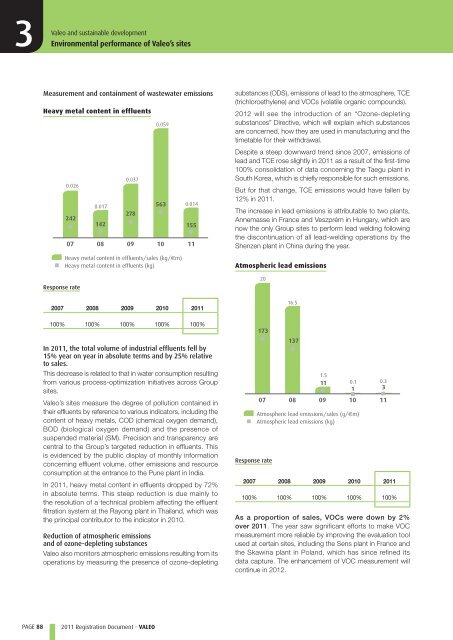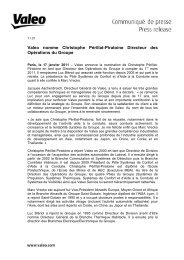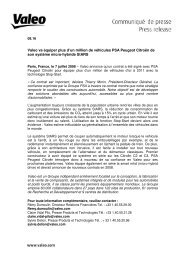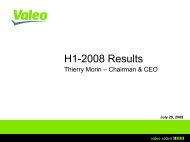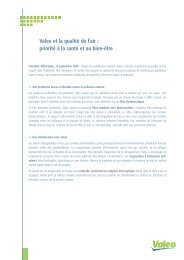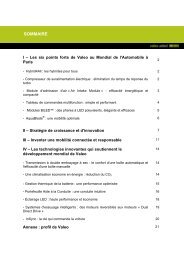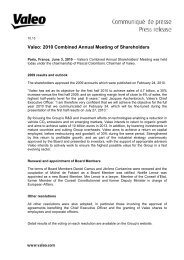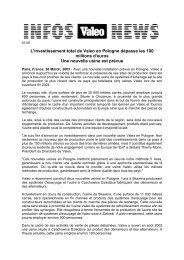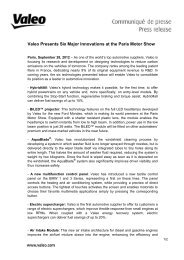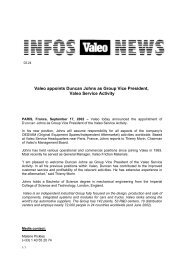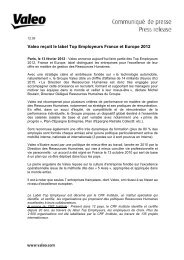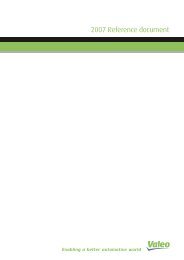2011 Registration Document - Valeo
2011 Registration Document - Valeo
2011 Registration Document - Valeo
Create successful ePaper yourself
Turn your PDF publications into a flip-book with our unique Google optimized e-Paper software.
3 <strong>Valeo</strong><br />
PAGE 88<br />
and sustainable development<br />
Environmental performance of <strong>Valeo</strong>’s sites<br />
Measurement and containment of wastewater emissions<br />
Heavy metal content in effluents<br />
0.026<br />
242<br />
Response rate<br />
0.017<br />
142<br />
0.037<br />
278<br />
<strong>2011</strong> <strong>Registration</strong> D ocument - VALEO<br />
0.059<br />
563<br />
155<br />
07 08 09 10 11<br />
Heavy metal content in effluents/sales (kg/€m)<br />
Heavy metal content in effluents (kg)<br />
0.014<br />
2007 2008 2009 2010 <strong>2011</strong><br />
100% 100% 100% 100% 100%<br />
In <strong>2011</strong>, the total volume of industrial effluents fell by<br />
15% year on year in absolute terms and by 25% relative<br />
to sales.<br />
This decrease is related to that in water consumption resulting<br />
from various process-optimization initiatives across Group<br />
sites.<br />
<strong>Valeo</strong>’s sites measure the degree of pollution contained in<br />
their effluents by reference to various indicators, including the<br />
content of heavy metals, COD (chemical oxygen demand),<br />
BOD (biological oxygen demand) and the presence of<br />
suspended material (SM). Precision and transparency are<br />
central to the Group’s targeted reduction in effluents. This<br />
is evidenced by the public display of monthly information<br />
concerning effluent volume, other emissions and resource<br />
consumption at the entrance to the Pune plant in India.<br />
In <strong>2011</strong>, heavy metal content in effluents dropped by 72%<br />
in absolute terms. This steep reduction is due mainly to<br />
the resolution of a technical problem affecting the effluent<br />
filtration system at the Rayong plant in Thailand, which was<br />
the principal contributor to the indicator in 2010.<br />
Reduction of atmospheric emissions<br />
and of ozone-depleting substances<br />
<strong>Valeo</strong> also monitors atmospheric emissions resulting from its<br />
operations by measuring the presence of ozone-depleting<br />
substances (ODS), emissions of lead to the atmosphere, TCE<br />
(trichloroethylene) and VOCs (volatile organic compounds).<br />
2012 will see the introduction of an “Ozone-depleting<br />
substances” Directive, which will explain which substances<br />
are concerned, how they are used in manufacturing and the<br />
timetable for their withdrawal.<br />
Despite a steep downward trend since 2007, emissions of<br />
lead and TCE rose slightly in <strong>2011</strong> as a result of the first-time<br />
100% consolidation of data concerning the Taegu plant in<br />
South Korea, which is chiefly responsible for such emissions.<br />
But for that change, TCE emissions would have fallen by<br />
12% in <strong>2011</strong>.<br />
The increase in lead emissions is attributable to two plants,<br />
Annemasse in France and Veszprém in Hungary, which are<br />
now the only Group sites to perform lead welding following<br />
the discontinuation of all lead-welding operations by the<br />
Shenzen plant in China during the year.<br />
Atmospheric lead emissions<br />
20<br />
173<br />
Response rate<br />
16.5<br />
137<br />
1.5<br />
11 0.1<br />
1<br />
0.3<br />
3<br />
07 08 09 10 11<br />
Atmospheric lead emissions/sales (g/€m)<br />
Atmospheric lead emissions (kg)<br />
2007 2008 2009 2010 <strong>2011</strong><br />
100% 100% 100% 100% 100%<br />
As a proportion of sales, VOCs were down by 2%<br />
over <strong>2011</strong>. The year saw significant efforts to make VOC<br />
measurement more reliable by improving the evaluation tool<br />
used at certain sites, including the Sens plant in France and<br />
the Skawina plant in Poland, which has since refined its<br />
data capture. The enhancement of VOC measurement will<br />
continue in 2012.


